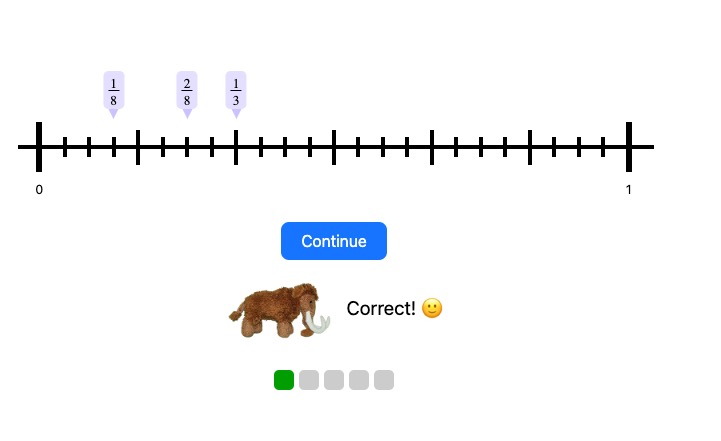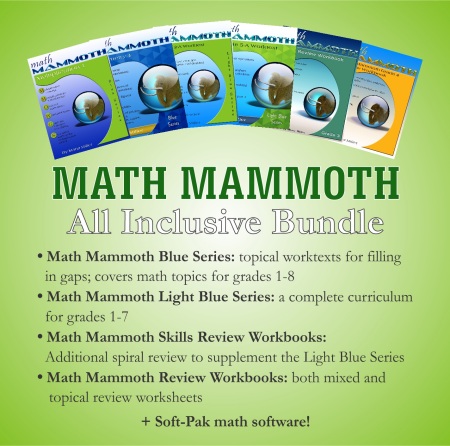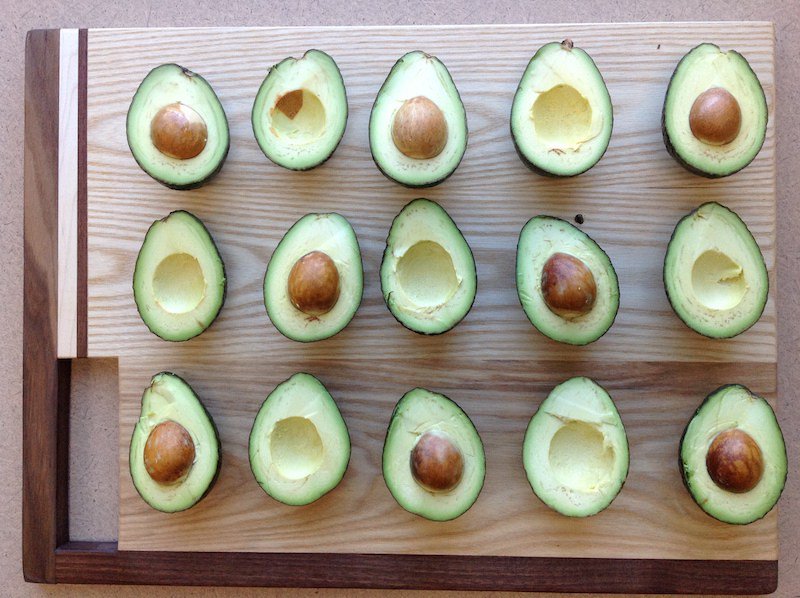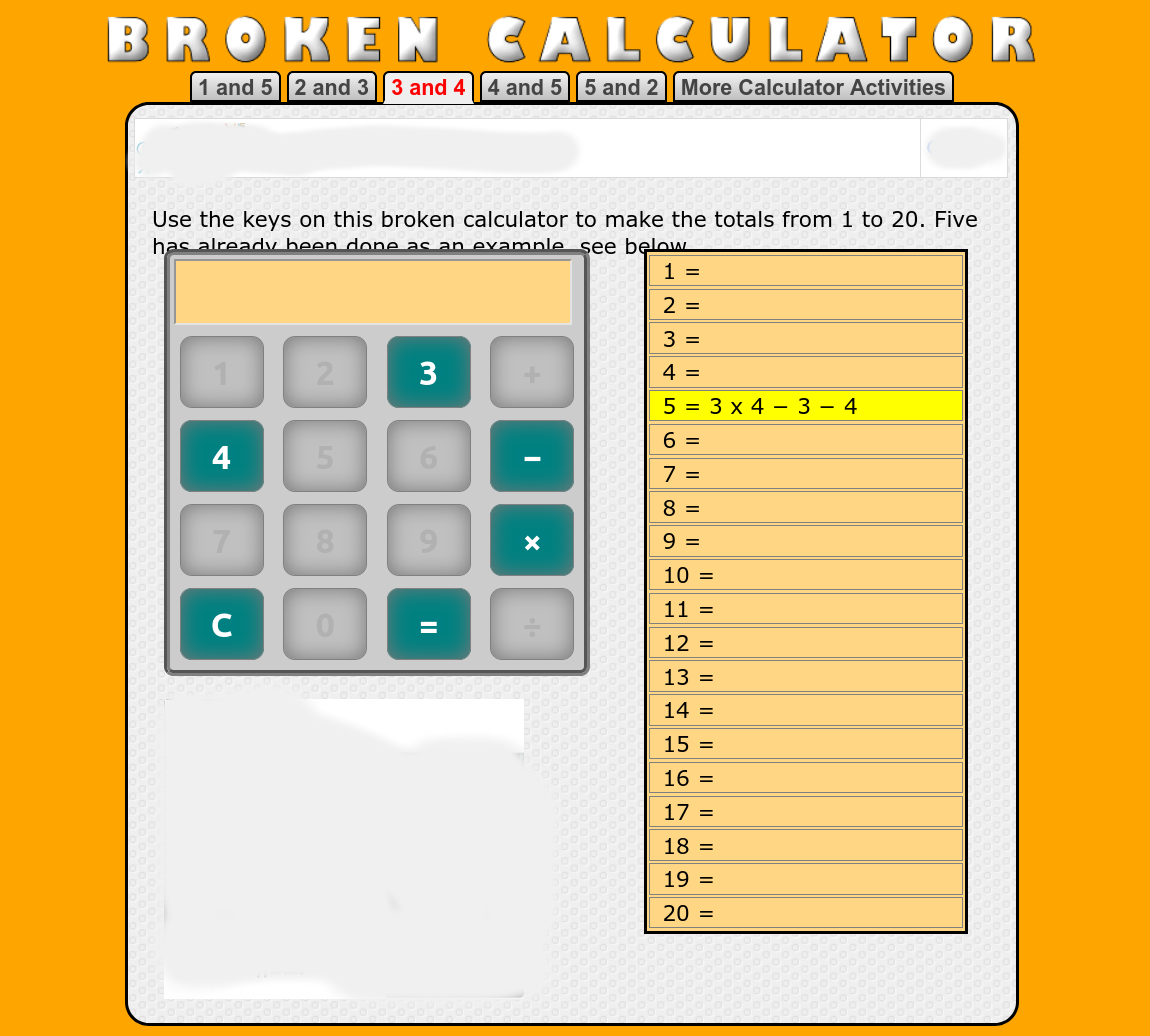 Hello again!!!
Hello again!!!
|
1. Math Mammoth newsI have something special for you — an exclusive giveaway just for my subscribers!Take part here: https://gleam.io/Xa93m/exclusive-giveaway-math-mammoth-products There are five different ways to enter! PRIZES
Click here to take part! A recent testimonial... 🙂 I had my daughter try several multiplication challenges yesterday, and she actually enjoyed them! I was surprised, knowing her reluctance to math. I truly am impressed with all the math games and studies on your site. The interactivity employed is capturing to a child. Great work! |
2. Don't assign all the problems!Here's a TIP for all Math Mammoth users. (I posted this five years ago but it might be good to mention it again.)Don't assign all the problems — unless it seems very necessary. One time, a customer wrote in, and I suggested to her to only assign 1/2 of the problems, and leave the rest for review later on. She had never thought of such and she felt it was a brilliant idea. This thought is actually mentioned in the Math Mammoth user guides... 😉 I know the curriculum is pretty much open-and-go so there's no obligation to read the user guide, but just keep in mind, you can definitely get creative in how you use Math Mammoth curriculum... and I WANT people to have that freedom. Don't be a slave to the curriculum! YOU are the teacher, the one that is guiding the process, so you have that privilege. 😊 You can even use MM in a spiral manner. Back 5 years ago when I posted this on Facebook, it generated a fair amount of discussion (check it out!). |
3. How many do you see? What is the "unit"?How many do you see? All you need is just a few minutes. Ask your child/student, "How many?" — and you can have a RICH mathematical discussion! In the avocado image, one could count the avocado halves — and then go on into counting how many ENTIRE avocados are there. What else? So simple and non-intimidating, yet you can find lots of neat math in these images. 🙂 It helps children learn about parts and wholes, and to use multiplication. There are images with dice, with pattern blocks, fruits, and more. Check out all of them at Math for Love - they even have a PDF with 40 such images for a free download: https://mathforlove.com/lesson/unit-chats/ |
4. Broken Calculator — fun practice for mental math & the order of operationsFor some reason, the order of operations has been the topic that I've received most notes about, as far as people suggesting there was an error in the answer key when there wasn't.I assume it used to be not taught very much, except in algebra. Personally, I feel that the main reason for teaching SOME aspects of the order of operations in the lower grades is so that children learn to write and to think of mathematical expressions with SEVERAL operations. This prepares them for algebra, but also is simply necessary in order to use math in real life. For example, let's say the task is to write a single "number sentence" for your change if you have $50 and you buy three shirts for $7 each. Writing the expression 50 − 3 × 7 and then finding its value gives them good practice concerning expressions. At the same time, it's necessary to talk about the order of operations in this context: multiplication is done first, before subtraction. (And that's how you do it when shopping, also.) Here's some fun practice the order of operations — in particular, with multiplication and subtraction — Broken Calculator: You're limited to multiplication and subtraction, but that also makes it, in a sense, easier, since students don't have to take division into account. I feel this is a wonderful game-like activity to help students remember that multiplication is done before addition/subtraction. And it hones your mental math skills, too! This suits best 3rd and 4th grades but works for any grade after that as a fun mental math activity. Check out the Broken Calculator game! |
5. New at Math Mammoth PracticeAnother new activity at Math Mammoth Practice: Order Fractions on a Number Line. In this activity, you will order three fractions on the number line. When the fractions have different denominators, you will need to find a common denominator for them, using the principles of equivalent fractions. This is good practice especially for 5th grade, and to some extent even for 4th grade. If you choose the same denominator, you can use it in 3rd. |
6. Just for fun!
Thanks for reading! 🙂 Feel free to forward this issue to a friend/colleague! Subscribe here. Till next time, Maria Miller |
| Complete curriculum | Math games and interactive practice | Math Mammoth freebies | New to MM? Start here |
| Privacy & your personal data | Are You Thirsty? | Blue Series: For filling in gaps |


